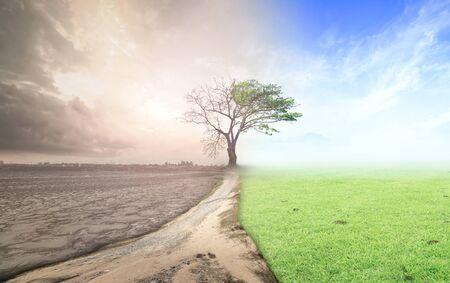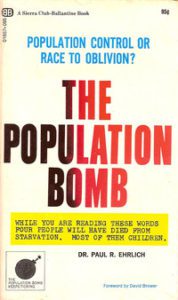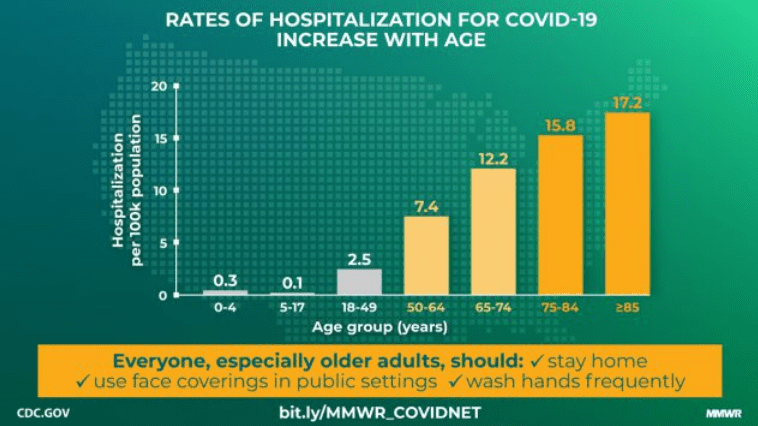
A faithful Young Women’s leader here in Wisconsin was recently teaching some of her young women about the importance of family and the sacred blessings that come from raising children. One girl raised her hand and said she didn’t think she should have any children because her teachers at school had explained that the earth is about to run our of air and water, making this a terrible time to bring more children into the world. Perhaps the teacher was trying to say that air and water pollution are unsolvable problems, or that water shortages are becoming dangerous threats, which would be less ridiculous than saying that we are running out of the abundant water and oxygen on this planet. But even if we finesse what the teacher might have said, the message the girl took away from class was a damaging lie, similar to lies that many of our children are being told in popular media and in school: this is a bad time to be alive and a terrible time to have children. Earth cannot support more people. We live in a world of gloom and despair where not having children is the virtuous and wise thing to do.

This message of impending doom on the planet is not new. It was a big deal when I was a teenager. After Paul Ehrlich’s widely and constantly acclaimed book, The Population Bomb, was published in 1968, there was widespread gloom about the impending disaster we faced because of too many people. Overpopulation was going to cause widespread famine right here in the United States by 1984. Having more kids was the worst thing we could do. A terrible mistake. In the 1970s, some people virtue signaled by saying that they were refusing to have kids so they would not deplete the scarce resources of the planet and contribute to the impending disaster, for earth had already reached its maximum capacity and there was no more room in the global inn. We were almost out of food and energy. The earth, with its 3.7 billion people in the early 1970s, was about to collapse with global famine and disaster.
Virtually every prediction Paul Ehrlich made in his horrifying book was not just wrong, but radically wrong. Food, metals, medicine, and energy have become vastly more abundant since that time. Today the earth has over twice as many people, and there is no need for famine. Life expectancy has increased. Opportunities for good health, education, and and a decent life are greater than ever, in spite of the tragically bad behavior of many wicked people in power that make life hard on others. Agricultural productivity has dramatically increased. Safe, fresh drinking water is being brought to more parts of the world. New technologies have made energy more available. The worst shortages tend to come from governments when they wage war as we see in Ukraine and Yemen, causing huge humanitarian crises, or otherwise prevent the manufacture or sale of needed items. The worse disasters of the past century, such as the famine in Ukraine and much of the Soviet Union in the 1930s that killed millions, of the famines in China caused by the Great Leap Forward and the ravages of the Cultural Revolution, are not to be blamed on God’s inadequate engineering of a planet stretched too thin.
Our children and adults need to understand how the gloomy message of doom we hear from many influential voices contrasts with the optimistic but realistic revelation that was given to Joseph Smith in Section 104 of the Doctrine and Covenants, which speaks of the blessings God has given us but also the great responsibility we have as stewards:
13 For it is expedient that I, the Lord, should make every man accountable, as a steward over earthly blessings, which I have made and prepared for my creatures.
14 I, the Lord, stretched out the heavens, and built the earth, my very handiwork; and all things therein are mine.
15 And it is my purpose to provide for my saints, for all things are mine.
16 But it must needs be done in mine own way; and behold this is the way that I, the Lord, have decreed to provide for my saints, that the poor shall be exalted, in that the rich are made low.
17 For the earth is full, and there is enough and to spare; yea, I prepared all things, and have given unto the children of men to be agents unto themselves.
18 Therefore, if any man shall take of the abundance which I have made, and impart not his portion, according to the law of my gospel, unto the poor and the needy, he shall, with the wicked, lift up his eyes in hell, being in torment.
There is enough! When there is poverty, hunger, or thirst, the problem is not an insufficient earth, but insufficient efforts to share the abundance with those in need. There is poverty, and we are needed as stewards to step up and help eliminate it. There is pollution, and good people are needed to be stewards to reduce it without creating poverty. There are solutions and there is abundance meant for all, and we are to be stewards to help bring abundance and hope to others with the blessings we have.
Perhaps it took faith in 1834 or in 1968 to believe that the earth had enough and to spare for all, but what we have seen in recent decades provides strong logical and scientific support for the notion that the earth truly is a place of abundance, especially when creativity and inventiveness are coupled with one of the most precious gifts of all, freedom.
The doomsday mythology of Ehrlich and others fundamentally misunderstands that they key to abundance is not any particular limited product, but human creativity that can cope with scarcity by not just conserving and recycling but especially by creatively finding new sources or alternatives, often by the power of incentives to continually solve problems when free markets exist. The scarcity of natural rubber for tires has been replaced with polymers made from other much more abundant materials. The scarcity of vacuum tubes for computers has been replaced by silicon made from endlessly abundant sand, allowing surges in productivity and abundance in almost every area of life. Agricultural productivity has surged with new knowledge, new tools, and new materials like better fertilizers. The earth can support vastly more people than Ehrlich ever imagined. If only we live up to our stewardship, there is truly enough for all and for many more.
Let’s Give Our Children the Perspective of History
We face great problems right now ranging from economic disasters such as inflation, environmental challenges such as pollution, violence in our streets, COVID, poverty, etc. There’s much to do to prepare for and overcome these challenges. But so many of the children and adults that are stressed over the future fret in almost total ignorance of what their ancestors fretted over. When that young woman in Wisconsin was being told by her teachers that we live in a terrible time to raise children, she was being taught in a school building abounding in luxuries that not even the wealthiest of kings of great nations enjoyed throughout most of recorded history: air conditioning, electric lights, flush toilets, and fresh running water. She would have lunch in cafeteria with fresh produce and meat kept cool by one of the most wondrous of inventions in the history of mankind, refrigeration. Her food was brought to her by a global supply chain able to make delightful products from distant countries, like bananas or chocolate, available on her plate.
She probably went to school in a vehicle that would have been beyond the imagination of any of her ancestors beyond 150 years ago: a vehicle that doesn’t leave the streets filled with horse manure, that doesn’t jolt you painfully every few yards or require you to endure insects and weltering heat or bitter cold, that drives swiftly and smoothly in air-conditioned comfort. When she needed to communicate with someone, she could hold a device in her hand and instantly call people far away to communicate. Alexander the Great might have given half his kingdom for the power such a tool could have given him. Just a few decades ago, family members separated in a time of chaos might have little hope of ever seeing each other again. Today we can call loved ones far away with voice and video and plan a reunion, or arrange for a ride home from school when there’s a change in plans.
Hold on, the biggest blessing that young woman was experiencing while being taught might not have been the comfort, the lights, the bathrooms, the water, or the food, or even her cell phone, but the fact that the was in a school receiving any kind of education at all. So few of our ancestors had that privilege, especially women. Today women and men can go through years of education and have access to almost any field of endeavor. More than public or private education alone, we can all have easy access to treasures of literature and knowledge in free libraries, in online resources, often at our fingertips. What an incredible time to be alive!
For our ancestors and for much of the earth throughout human history, the typical issue they faced day after day was not which college to attend or what major to choose, how to balance work and family, how to afford a family vacation, how to get acne under control, or how to buy a car that is affordable and has good gas mileage, or how best to virtue signal when there’s a crisis. The primary issue was how to survive. How to avoid the plague that had just wiped out 40% of my village, or how to find enough food to keep my family alive one more week, or how to avoid being slaughtered by the city-state a few miles away that might invade at any time. Climate fears were very real then: winter cold might mean freezing to death; spring rains might wash away one’s crops or home; and summer heat might kill the sick and old, while bringing swarms of insects to invade homes and eat crops.
Then there was childbirth. To bear a child in the past was an act of to me almost unimaginable bravery. Huge numbers of women died in childbirth. Today the number is around 20 per 100,000 births. Still a genuine risk, but it’s very rare and mostly preventable, according to the CDC (also see Wikipedia’s article). For healthy young women in their 20s, it much rarer than the overall number. Further, women bearing children today have access not just to emergency surgery if needed for and to clean water and air conditioning, but can have an epidural to reduce the pain. Has there every been a better era to face the challenges of childbirth?
History matters. In reading the histories of China, Central Asia, Europe, Africa, or the New World, for example, it is always astounding to think just how unsafe the world was. Cities often needed fortifications and walls because of the perpetual risk of attack form neighboring cities or empires. Megalomaniacs like Tamerlane with their hordes of soldiers would rampage across the land and take delight in massacring entire cities that didn’t yield immediately to their brutality, even making monuments of tens of thousands of stacked skulls to show off their might. Powerful walls would fall to invaders like the Crusaders who would then spend decades looting and destroying one of the grandest cities on earth, Constantinople. Even when fortifications and armies seemed secure, all could be lost with plagues spread by foul water and despicable sanitation, and abundant supplies might quickly give way to famine when crops failed or rain failed to come.
Here’s a perspective on history from Jack Raines in “What a Time to Be Alive“:
If we were living in Alexandria in year 0, Kyoto during the samurai era, Stockholm in 1655, or Paris during Napoleon’s reign, each of us would have had a coin flip’s chance of surviving adolescence. Maybe we wouldn’t have survived our own births. Maybe we would have fallen victim to famine, sickness, war, infection, labor, or an abundance of other adverse conditions.
From 500 BC to 1900 AD, death reigned supreme. The world’s average youth mortality rate, defined as death before age 15, was 46.7%. Additionally, one-quarter of all infants didn’t reach their first birthdays.
For 2400 years, your odds of reaching your 15th birthday were reduced to the spin of a roulette wheel. But over the last century, everything changed.
By 1950, the global youth mortality rate had nearly been cut in half to 27%. In 2017, we hit 4.6%. Somalia, which currently boasts the world’s highest youth mortality rate at 14.8%, sits at just 1/3 of the global average from ~100 years earlier.
In 2022, the death of a child is a tragic occurrence. In 1822, it was a normal part of daily life. We can’t comprehend a world where early deaths were so common, yet that was the real world for millennia.
Static mortality rates for centuries, then a 90% decline in just a few generations. Insane progress.
Poverty
In 1820, with a global population of 1.08B, 964.93M people lived in extreme poverty (living on less than $1.90 per day in 2015, adjusted for inflation). In 2015, with a global population of 7.35B, 733.48M people lived in extreme poverty. While the world’s population increased by 6.3B, the number of people living in extreme poverty decreased by 230M.
We often focus on wealth inequality in the US. And it’s true, the wealth gap is growing. But what gets missed in this wealth gap comparison is just how much better off poor people are now than at any point in the past.
You can be “poor” in the United States today and have a cellphone, an internet connection, food, and shelter. Those living in government housing today have a higher standard of living than the upper class did in year 1900. JD Rockefeller, the richest man in modern history, didn’t even have air conditioning.
As recently as 1981 (!!!) 42% of the world lived in extreme poverty. Today, that number is just 9%. In the last generation, global extreme poverty has dropped by 84%.
Earth has been a rough, uncomfortable, and often deadly place since the beginning, but today we have incredible blessings and opportunities often unavailable to, if not unimaginable by, even the wealthiest of old. We have safe, clean water. We have much fresher air than wood-, coal- and manure-burning cities knew. We can read, work, or cook at any time with electricity and other energy sources. We dwell in comfort with air conditioning. We can travel across town in minutes or across the globe in hours, with almost no risk. We enjoy abundant food and spices from all over the planet. When ill, we have medical care without leaches that is more likely to help than hurt.
A pregnant mother and her baby as much more likely to survive birth, and that baby is much more likely to survive into adulthood, than ever before. That’s just one of many reasons why this is a time of great hope and opportunity.
This is a time to shout for gratitude. It is one of the best times in world history to be alive, and especially for those in the United States where we have been largely free of the ravages of war inside our borders. There are many problems, problems of violence in our cities, including horrific violence against children (both post-natal and pre-natal, with over 63 million causalities in recent decades in that latter category), economic problems, problems of hate and cruelty, but these are largely man-made problems that we can solve by raising our voices against evil, by raising our hands for good, and by raising our children with strong values such as charity for others and faith in God. It’s a time when above all, we need more good people, more people who can live and teach the Gospel of Jesus Christ.
Our greatest need in this greatest of all times may be to raise great children who can apply the creativity, faith, and love needed help the world overcome its greatest problems.
This is not the time to despair and give up because of the message of gloom from our schools and mass media. This is not the time to be depressed by the Adversary or confused by his attacks on our divine roles as men and women with the potential to raise families, a vital part of God’s great and endless work. This a grand moment in history when there has never been so much to rejoice over and so much good to be done in our role as stewards, both as stewards over material things as well as sacred things, including the sacred stewardship of being parents. This is not the time to submit to gloom and walk away from our joyous destiny.











Mr. Lindsay,
I stumbled across your blog years ago and have visited it sporadically over the years. I have always found it interesting and insightful. I am a member of a restoration branch, fundamental RLDS from Independence, Missouri.
I just wanted to say I like the new design and name and I enjoyed your posts about a terrible time to be alive and Roe vs. Wade. Very well written. I have been depressed lately by the news and our world situation and your article about a terrible time to be alive helped me realize that I was focusing on the wrong side of things.
Thank you. I will continue to check out your posts in the future. Keep up the good work.